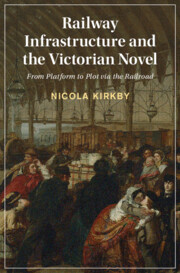Refine search
Actions for selected content:
232 results
Cultures of Power: Electrification, Politics, and Visibility in Greater Los Angeles
-
- Journal:
- Enterprise & Society , First View
- Published online by Cambridge University Press:
- 19 November 2025, pp. 1-11
-
- Article
-
- You have access
- Open access
- HTML
- Export citation
Building Legacy: Sports, Kasarani Stadium, and Moi’s Transnational Populist Politics, 1978–87
-
- Journal:
- The Journal of African History / Volume 66 / 2025
- Published online by Cambridge University Press:
- 12 November 2025, e26
-
- Article
-
- You have access
- Open access
- HTML
- Export citation
15 - One Health and Multispecies Urban Infrastructure
- from Part III - One Health and Future Legal Structures
-
-
- Book:
- The Cambridge Handbook of One Health and the Law
- Published online:
- 25 September 2025
- Print publication:
- 09 October 2025, pp 230-243
-
- Chapter
- Export citation
Chapter 2 - Perpendicular Publics
-
-
- Book:
- British Law and Literature in the Long Eighteenth Century
- Published online:
- 19 September 2025
- Print publication:
- 09 October 2025, pp 45-63
-
- Chapter
- Export citation
A Semiotics of Coziness and Disappearing Night
-
- Journal:
- Signs and Society ,
- Published online by Cambridge University Press:
- 08 October 2025, pp. 1-30
-
- Article
-
- You have access
- Open access
- HTML
- Export citation
5 - How Visibility Projects Ended Marketization in the Urban Bus Sector
-
- Book:
- Politicizing Business
- Published online:
- 29 September 2025
- Print publication:
- 25 September 2025, pp 95-114
-
- Chapter
- Export citation
4 - Transformation
- from Part II - Working Environments: Extraction and the Making of Place
-
- Book:
- Burning Swamps
- Published online:
- 06 September 2025
- Print publication:
- 25 September 2025, pp 134-168
-
- Chapter
- Export citation
4 - Visibility Projects and the End of Marketization in China’s Urban Bus Sector
-
- Book:
- Politicizing Business
- Published online:
- 29 September 2025
- Print publication:
- 25 September 2025, pp 79-94
-
- Chapter
- Export citation
2 - Visibility Projects, the First Political Service
-
- Book:
- Politicizing Business
- Published online:
- 29 September 2025
- Print publication:
- 25 September 2025, pp 37-65
-
- Chapter
- Export citation
5 - Adapting to Climate Change in NYC
-
- Book:
- Local Greens
- Published online:
- 11 October 2025
- Print publication:
- 18 September 2025, pp 72-86
-
- Chapter
- Export citation
Introduction
-
- Book:
- Railway Infrastructure and the Victorian Novel
- Published online:
- 12 August 2025
- Print publication:
- 28 August 2025, pp 1-23
-
- Chapter
-
- You have access
- HTML
- Export citation
5 - Realization of Modernization Dreams?
-
- Book:
- A History of India's Green Revolution
- Published online:
- 07 August 2025
- Print publication:
- 21 August 2025, pp 159-192
-
- Chapter
- Export citation

Railway Infrastructure and the Victorian Novel
- From Platform to Plot via the Railroad
-
- Published online:
- 12 August 2025
- Print publication:
- 28 August 2025
Infrastructural Violence, Environmental Injustice, and Decolonial Repair: The Case of South Durban Basin
- Part of
-
- Journal:
- Public Humanities / Volume 1 / 2025
- Published online by Cambridge University Press:
- 04 August 2025, e116
-
- Article
-
- You have access
- Open access
- HTML
- Export citation
3 - Wartime Granary Networks and the “Science” of Storing Grain
-
- Book:
- Grains of Conflict
- Published online:
- 23 August 2025
- Print publication:
- 31 July 2025, pp 107-149
-
- Chapter
- Export citation
Chapter 27 - India Stack
- from Part IV - Digital Technologies and the Future of Financial Infrastructure
-
-
- Book:
- The Cambridge Global Handbook of Financial Infrastructure
- Published online:
- 21 May 2025
- Print publication:
- 05 June 2025, pp 336-346
-
- Chapter
-
- You have access
- Open access
- HTML
- Export citation
Chapter 24 - Social Media and the Changing Infrastructures of Money
- from Part IV - Digital Technologies and the Future of Financial Infrastructure
-
-
- Book:
- The Cambridge Global Handbook of Financial Infrastructure
- Published online:
- 21 May 2025
- Print publication:
- 05 June 2025, pp 299-308
-
- Chapter
-
- You have access
- Open access
- HTML
- Export citation
Chapter 31 - AI as Financial Infrastructure?
- from Part IV - Digital Technologies and the Future of Financial Infrastructure
-
-
- Book:
- The Cambridge Global Handbook of Financial Infrastructure
- Published online:
- 21 May 2025
- Print publication:
- 05 June 2025, pp 386-400
-
- Chapter
-
- You have access
- Open access
- HTML
- Export citation
Chapter 2 - Derivatives, Market Liquidity, and Infrastructural Finance
- from Part I - Conceptual Approaches
-
-
- Book:
- The Cambridge Global Handbook of Financial Infrastructure
- Published online:
- 21 May 2025
- Print publication:
- 05 June 2025, pp 13-25
-
- Chapter
-
- You have access
- Open access
- HTML
- Export citation
19 - Local Government Law for the 100-Year Life
- from Part IV - The 100-Year Life and Our Broader Environment
-
-
- Book:
- Law and the 100-Year Life
- Published online:
- 13 May 2025
- Print publication:
- 29 May 2025, pp 258-270
-
- Chapter
-
- You have access
- Open access
- HTML
- Export citation
